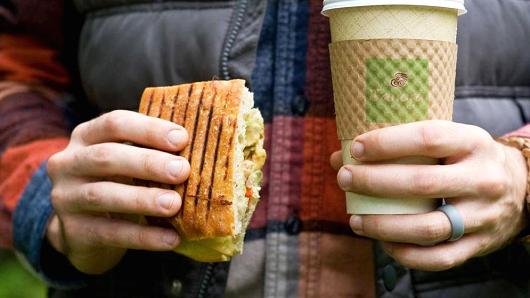- Panera to hire 10,000 employees as it expands its delivery service
- The company hopes to expand delivery to 35 percent to 40 percent of its locations
- Panera forecasts that delivery will add $250,000 per year to each store’s annual revenue
Panera Bread is going full-steam ahead to expand delivery services to more of its cafes.
The sandwich shop said it intends to hire 10,000 new employees by the end of the year to assist with this initiative. Some 75 percent of the new hires will be delivery drivers, while the remaining 25 percent will be in-cafe jobs, according to Blaine Hurst, president Panera.
Panera has already rolled out delivery to 15 percent of its system, including 20 percent of its company-owned locations. By the end of 2017, it hopes to expand delivery to 35 percent to 40 percent of system-wide locations.
Hurst expects each cafe to hire seven to 12 drivers and staff members. He said it would cost about $25,000 per cafe to add delivery capabilities, the majority of which goes toward hiring and training labor.
Panera is in the process of being acquired by privately held JAB Holding in a deal valued at about $7.5 billion.
Drivers will be vetted by the company, said Hurst. Their insurance, driving records and car will all be inspected in order for the drivers to be hired and certified to work. Hurst said drivers’ cars will be inspected on a regular basis and drivers will be compensated for their mileage.
By using this Uber-style method, Panera does not have to invest in its own fleet of vehicles. But by screening the drivers itself, it has more control over the guest experience.
The restaurant has also created a new order tracking system that allows customers to see their meals’ expected arrival time, a map of the driver’s progress and a photograph of their driver.
The minimum menu purchase is $5 and the typical delivery fee will be $3, according to the company. Hurst told CNBC that the average check is about $22.
Panera initially tested delivery by using third parties to bring its food to customers, however, it was not satisfied with the results. Instead, the company is using internal team members so that it could offer a reliable and accurate service to customers, Hurst told CNBC.
Hurst said the company wasn’t able to find a delivery partner that “could cover [Panera] at the scale that [it’s] currently at.”
Not to mention, third-party delivery services can charge fees of 5 percent to 30 percent to companies, according to David Tarantino, an analyst at Baird.
After the initial financial investment and about three to six months of transition, most cafes are about to garner about $5,000 a week. Delivery, Hurst said, is about 10 percent of sales in these cafes.
Panera operates in a restaurant category that is well positioned to succeed in the delivery space, Tarantino said.
“Our instinct is that fast-casual chains should have the best opportunity to capture share within the delivery channel based on the quality of food offerings and the segment’s moderate price points,” Tarantino wrote in a research note Friday, ahead of Panera’s announcement. “We suspect price points could limit the potential for quick service chains (possibly too low in relation to delivery fees) and casual dining (possibly too high for a non-service oriented occasion).”
Panera forecasts delivery will add $250,000 per year to each store’s annual revenue of $2.6 million.

